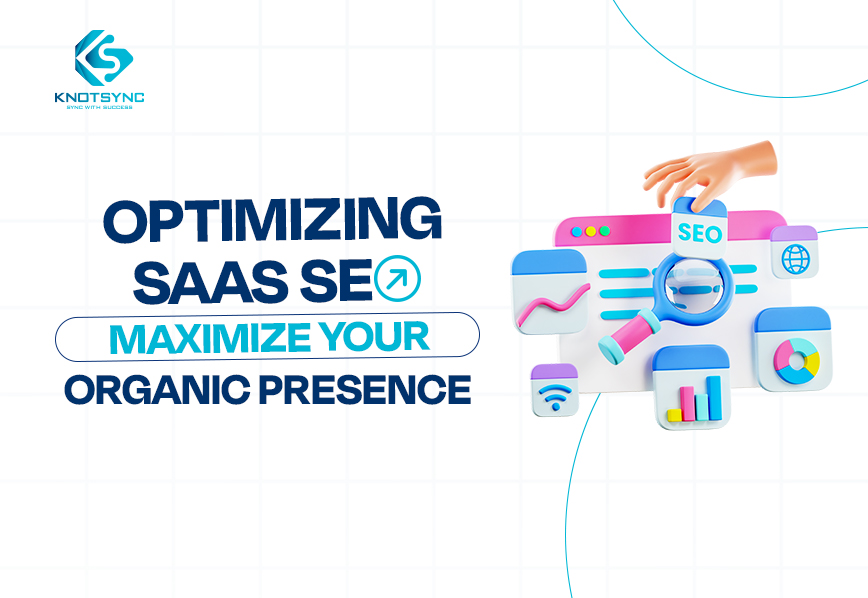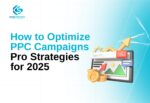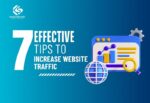If you’re running a SaaS business in 2025, your product won’t sell itself. No matter how brilliant your software is, if the right people can’t find it, then your growth will stall. That’s where SaaS SEO comes in. If you know your audience and what type of services they are looking for, you can easily attract them using SaaS SEO to drive traffic to your website.
With a proper SEO technique, you stay ahead of your competitors and can make your SaaS business successful and profitable. Unlike paid campaigns, SEO grows over time and brings in potential customers who are searching for solutions like yours.
But, before you start looking at the best SEO practices and guides you can use, let us see and understand what SaaS SEO is and its benefits.
What is SaaS SEO and Why Does it Matter?
If you think SEO is just about sprinkling keywords on a page, then think again. SaaS SEO focuses on search engine optimization strategies specific to software platforms distributed as a service.
It involves understanding how your potential customers search for solutions, what problems they’re trying to solve, and how you can position your product as the obvious choice. With a dedicated SaaS SEO plan, companies can establish an authoritative online presence, expand their audiences, and fortify their market positions.
At its core, SaaS SEO combines three key elements:
- Audience Understanding: Knowing who your customers are, what problems they face, and the search terms they use is the foundation of any effective SaaS SEO strategy.
- Content Optimization: Crafting content that not only targets the right keywords but also educates, engages, and converts readers into leads — one of the most effective content marketing tips for driving results.
- Technical Excellence: Ensuring your website structure, speed, mobile experience, and indexing are optimized so search engines can easily find and rank your content.
Why does this matter? Because SaaS SEO isn’t just about ranking, it’s about building long-term visibility and credibility.
When your site consistently appears for the right searches, it not only drives qualified traffic but also positions your brand as a trusted and authoritative product in your niche. That authority leads to trust, more signups, and a sustainable competitive advantage.
Think of SaaS SEO as the engine that keeps your growth machine running; without it, even the best product can stay unnoticed.
Why is SEO Important for SaaS Businesses?
The SaaS market in 2025 is really crowded; there’s a new product launching almost every day. Although paid ads can get you quick visibility, they’re expensive and stop working the moment you pause your budget. SEO, on the other hand, is the growth channel that keeps giving.
Further, with the proper SEO, SaaS business can easily optimize their website content and structure to attract and convert visitors into potential customers.
This can help them reach a new audience, increase website visibility, and lower the overall customer acquisition cost. Now, let us see the critical benefits of SEO for your SaaS business:
1. Improved Website Ranking
Ranking for target keywords through optimized on-page and off-page optimizations helps the website gain prominence in search results. This visibility generates continuous awareness of the brand and software solutions. You can learn some of the best ranking tips for better SERPs.
2. Consistent Organic Traffic
With SEO, your website attracts users who are actively searching for solutions like yours. Instead of chasing customers, you’re bringing them straight to your doorstep. This means your funnel is always active, even while you sleep.
3. Reach Your Potential Customer
SEO supports finding niche target audiences by optimizing for their long-tail search queries. It helps SaaS businesses effectively position themselves to specific buyer groups relevant to the software functionality and pricing plans.
4. Lower the Customer Acquisition Cost
One of the biggest challenges in SaaS is the high cost of acquiring customers. Paid ads, sponsorships, and events can drain your budget quickly. SEO, however, helps you lower CAC by driving sustainable traffic without ongoing ad spend. The more your content ranks, the more affordable your growth becomes.
5. Provide a Smooth User Experience
Optimizing site structures, pages, and content through SEO strengthens user experience. It helps users quickly find relevant products and information to solve problems. This may help them quickly resolve queries, simplify comparisons, and streamline purchase decisions.
With the correct organic rankings, SaaS businesses can steadily drive qualified traffic to their site. This can help them boost trial conversions and user retention over the long run, and lower new customer acquisition costs – all of which are key business metrics for the industry.
Top 8 SaaS SEO Strategies to Maximize Your Organic SEO Presence
Search engines help thousands of users find relevant information online every minute. For SaaS businesses, this presents a massive opportunity, especially since 66% of B2B SaaS buyers use search engines to research solutions before purchasing.
This shows that using SEO for your SaaS business can help you capture this online traffic and boost rankings. Let us see some of the SaaS SEO optimization strategies in 2025 that you can use to increase your organic presence online:
1. Do Research Keywords Your Customers are Searching
Think of keywords as the “language of your customers.” If you don’t know how people are searching for your software, then you’ll miss opportunities to appear in front of them. Here’s how you can do your keyword research:
- Identify Intent-Driven Keywords: Thorough and detailed keyword research is essential to target the right long tail and commercial keywords aligned with your business. Instead of using broad terms like “CRM software focus on long-tail keywords with purchase intent, for example, “best CRM for small B2B companies.” These keywords bring in visitors closer to making a decision.
- Use the Right Tools: Keyword research tools like Google Keyword Planner, SEMrush, or Ahrefs can identify trends, search volume, difficulty for keywords, and even what your competitors rank for.
- Create a Keyword Road Map: Selecting 2-3 low-competition keywords per page to prevent overlap. This ensures your pages complement each other instead of competing in Google.
By doing this, you’ll know exactly what your prospects are searching for, and you can position your SaaS product as the solution.
2. Write Product-Led Content
In SaaS, your content shouldn’t just educate people, it should also demonstrate how your software solves real-world problems. This is called product-led content.
Create content that illustrates how your product can help solve different kinds of challenges. Users and search engines appreciate helpful content that answers specific questions.
Writing articles with relevant keywords, catchy headlines, and easy navigation helps users understand more about your company and product. With the right content on your website, your authority is bound to increase over time.
Here’s how you can do it right:
- Write Educational Guides: For example, if you’re selling project management software, create content like “How to Streamline Remote Team Collaboration” and naturally weave in how your tool helps.
- Build Comparison Pages: Users often search for “Tool A vs Tool B.” Create honest, side-by-side comparisons where your SaaS stands out.
- Include Use Cases and Success Stories: Show your product solving pain points for specific industries or roles.
Generic blogs attract traffic but don’t convert. Product-led content ensures your readers not only learn something but also see your SaaS as the answer to their problems.
3. Use Alt Tag to Describe Your Image
SaaS products often involve complex features, and visuals make them easier to understand. But visuals also need SEO optimization. Here’s how you can optimize your visuals:
- Alt Text for Every Image: Instead of “screenshot1.png,” use “SaaS project dashboard showing team collaboration features.”
- Explainer Videos & GIFs: Visual demos reduce bounce rates and increase engagement time (a major ranking factor).
- Optimize File Sizes: Keep images under 100KB where possible to maintain fast load speeds.
Optimizing images with proper alt-text and embedding necessary multimedia improves engagement. It not only helps search engines see what your image is about but also helps the audience get a visual understanding of your product and services.
4. Attract More Clicks with Focused Titles and Meta Descriptions
Your title and meta description are your “billboard” in Google’s search results. They determine whether people will click through or scroll past.
Crafting optimized page elements like titles containing focus keywords, descriptive headers/footers, and compelling meta descriptions enhances click-through rates and rankings. The title appears on the search results page to help you attract clicks, while the meta description encourages users to visit your site.
Here’s how to include them correctly:
- Include your focus keyword early in the title. For example: “SaaS SEO Strategies for 2025: Boost Traffic & Authority.”
- Promise clear value in the meta description. Example: “Discover 8 proven SaaS SEO strategies to lower CAC, grow organic traffic, and build brand authority in 2025.”
- Stay within character limits: 50–60 for titles, 150–160 for descriptions.
Even if you rank high, poor titles and descriptions mean low click-through rates (CTR). High CTR signals to Google that your result is valuable, which can improve rankings further.
5. Add an XML Map to Improve the Chances of Website Ranking
XML Sitemaps work as a roadmap for search engines, informing search engines about pages to index and their frequent updates. They provide a view of the internal linking structure, helping search engines understand the best pages to prioritize.
Being XML compliant as per Google guidelines positively impacts your Google ranking. It ensures nothing gets missed and speeds up indexing, especially if you regularly add new features, blogs, or resources. Here’s how to do it:
- Generate Your Sitemap: Most CMS platforms like WordPress, HubSpot, or Shopify have tools/plugins to automatically create an XML sitemap.
- Add it to Google Search Console: This helps Google find your pages and can index them more efficiently.
- Keep it Updated: Every time you add, remove, or update pages, refresh your sitemap so search engines always have the latest version.
- Consider an HTML Sitemap for Users: While XML sitemaps are for search engines, HTML sitemaps help visitors navigate your site and strengthen internal linking.
6. Add Only Relevant Backlinks
Backlinks are still one of the strongest ranking signals. However, for SaaS companies, quality beats quantity every time. Requesting relevant sites, blogs, business listings, and review portals to link back with contextually aligned content improves your website’s domain authority. Here’s how you can do it:
- Guest Posting: Write for SaaS blogs, startup magazines, and industry publications.
- Partnerships: Collaborate with integration partners or influencers in your niche to cross-link content.
- Digital PR: Publish original data (like a SaaS trends report) and pitch it to journalists for coverage.
However, avoid black-hat tactics and focus on quality backlinks from authorities in your industry niche. When trusted sites link to you, it tells Google your content is credible, pushing you higher in rankings.
7. Improve Your Social Media Presence
Regularly posting on social media platforms like Facebook, Twitter, LinkedIn, and Instagram builds brand awareness and engagement. Although social media doesn’t directly impact SEO, it can amplify your reach and indirectly boost rankings. Here’s how:
- Distribute Your Blog Content: Posting helpful content and resolving/answering user queries can help you gain notice. Using proper hashtags, you can improve your social page discoverability and consistently strengthen your brand’s identity online.
- Engage in Conversations: Answer questions in SaaS-related threads or groups, linking to helpful resources on your site where relevant.
- Encourage Sharing: Use compelling visuals, quotes, or statistics to make your content more shareable.
8. Share Insights to Build Authority in Your Niche
The SaaS space is full of “me too” content. If you want to stand out, you need to publish content that others can’t replicate easily.
Share insights, data, and studies to build authority in your niche. This helps you establish your brand/company as a thought leader and trusted source of information. And with an authority, you can easily add new customers and boost your product signups. Here’s how you can do it:
- Publish Research Reports: For example, “State of SaaS SEO in 2025” with your own survey data.
- Use Customer Success Stories: Showcase real-world results, like “How X company cut CAC by 30% using our SaaS.”
- Offer Expert Commentary: Share predictions, frameworks, or unique insights that make you the go-to source in your niche.
When your content provides original value, it attracts backlinks, social shares, and higher engagement, all of which signal authority to Google.
Frequently Asked Questions (FAQs)
Even if you have a solid SEO plan, you probably still have questions about how to get the best results for your SaaS business. To make things easier, we’ve combined the most common questions that people ask about SaaS SEO in 2025.
1. What are the Top SaaS SEO Tools for 2025?
Top SaaS SEO tools include SEMrush, Ahrefs, Moz, and Google Search Console. They help you research keywords, track backlinks, monitor rankings, and audit your site’s SEO health. Using a mix of these tools gives you a complete picture of your SEO performance.
2. What Technical SEO Improvements Boost SaaS Rankings?
Key technical improvements include mobile-friendly design, fast page speeds, clean site structure, XML sitemaps, and structured data/schema markup. Optimizing these ensures that search engines can crawl and index your site efficiently while improving user experience.
3. How can Content Marketing Enhance SaaS Organic Traffic?
Content marketing attracts qualified leads by creating product-led guides, tutorials, and case studies targeting high-intent keywords. Well-crafted content also encourages backlinks and social sharing, which further boosts your organic visibility.
4. What are the Common SaaS SEO Mistakes to Avoid in 2025?
Common mistakes include ignoring technical SEO, targeting overly broad keywords, creating generic content, building low-quality backlinks, and neglecting UX. Avoiding these mistakes can help you get a steady traffic and more people takes actions.
Conclusion
When it comes to being at the forefront of SEO, SaaS companies can effectively enhance their organic search rankings and experience sustainable growth in the long run. By implementing strategic optimizations and staying abreast of emerging trends, SaaS companies can unlock the full potential of organic search and drive sustainable growth.
However, if you want to evaluate your digital presence but are unsure how to use SEO to build your website authority, attract new customers, and drive more traffic, you can reach out to an experienced, creative, driven Saas SEO agency.




